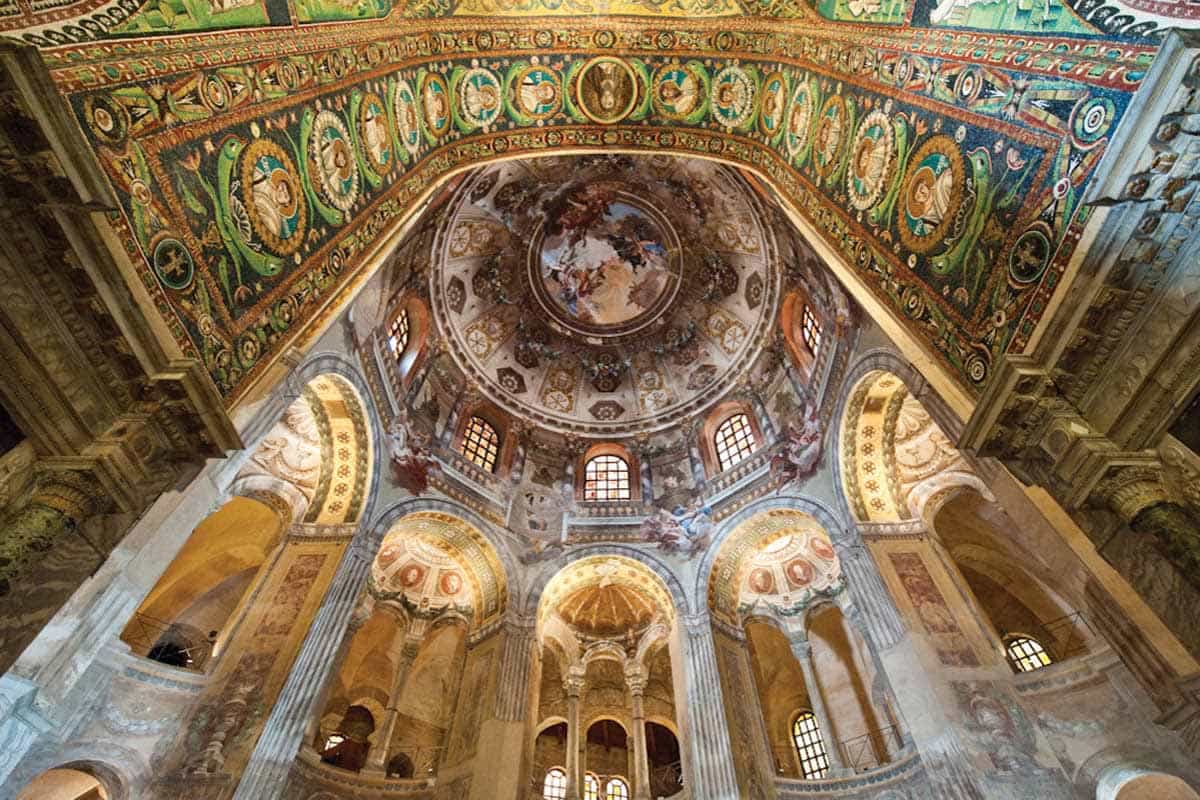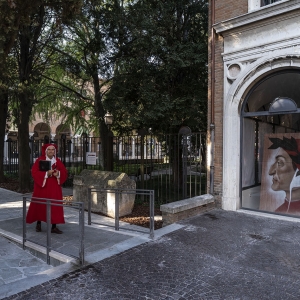RAVENNA
Where is located
Nestled a few kilometers from the Adriatic Sea, in the heart of Romagna, Ravenna is a chest of art, history and culture with an ancient and glorious past behind.
When to go and what to see
Besides the extraordinary richness of its monumental heritage, the few kilometres distance from the Adriatic coast make it a suggestive destination of relaxation, fun, as well as an ideal place for excursions immersed in nature.
With an efficient organization of services and a very wide offer, in Ravenna and its territory you can enjoy a holiday tailored on your needs: sun and relaxation, sea, games, sports and fitness activities, excursions and themed parks, all-sided by a varied and tasty gastronomic offer.
Do not miss
Besides a visit to the eight Unesco monuments (Basilica of San Vitale, Mausoleum of Galla Placidia, Neonian Baptistery, Chapel of Sant'Andrea or Archiepiscopal Chapel, Arian Baptistery, Basilica of Sant’Apollinare Nuovo, Mausoleum of Theodoric, Basilica of Sant’Apollinare in Classe), the cultural offer of Ravenna is rich and varied in every season of the year.
There are so many places to see: you can visit the MAR - Ravenna Art Museum, which besides permanent collections (such as the Contemporary Mosaics collections) organizes events and temporary high-profile collections; or the museum Tamo - All the Adventure of the Mosaic, hosted inside the complex of San Nicolò, with its permanent exhibition dedicated to the art of the mosaic from Antiquity to contemporary age, or again visit the National Museum of Ravenna with its rich collections: you will find out about the history of Ravenna through the many finds on display, including Roman and Byzantine finds coming from local excavations.
The suggestive “Zona del Silenzio” hidden in the city centre is absolutely worth seeing. The area includes Dante’s tomb, the Quadrarco di Braccioforte and the Basilica of San Francesco. Every year, in September, right in this area are taking place a series of celebrations and spectacular events paying homage to the Supreme Poet.
In the silent rooms of the Classense Library are displayed important objects linked to Lord Byron and other important historical figures, who stayed in the city. Moreover, the library hosts a huge collection of books and manuscripts, being one of the most prestigious library institutions in Italy.
The Planetarium of Ravenna is located inside the public gardens of the city (Giardini Pubblici), which, almost as a frame, overlook the 16th century-old Loggetta Lombardesca, house of the MAR Museum. The Brancaleone Fortress, of Venetian age, hosts a flourishing garden and the arena for open-air performances.
The importance of Ravenna between the 5th and the 6th century is testified by the precious mosaics guarded in the ancient late Christian and Byzantine buildings. Eight of these monuments have been inserted in the Unesco World Heritage list for their universal value, the unicity and the mastery of the mosaic art.
Nevertheless, many are the places of artistic and archaeological interest that marked the city's past, such as the Domus of the Stone Carpets, the Ancient Port of Classe, and the recent Classis Ravenna - Museum of the City and of the Territory.
If on the one hand, by the way, Ravenna has been the main western political and cultural centre over the centuries that followed the end of the Latin civilization's dominion, on the other hand it preserves important traces of more recent eras, from the Middle Ages until the contemporary age: the tomb of the Supreme Poet Dante Alighieri (with the suggestive “Area of Silence”), the Brancaleone Fortress, the Classense Library, the City Tower and its monumental gates are all proof of that.
The cultural offer of the city is rich and diversified, thanks also to a dense network of museum structures. Among the many already reported are added the Archiepiscopal Museum, which hosts the Chapel of Sant’Andrea (Unesco Heritage), Dante’s Museum with relics linked to the cult and the fame of Dante Alighieri, and the Byron Museum, connected to the memory of the English poet, which collects engravings, documents, objects of the Risorgimento and memories of Garibaldi.
Why visit it
Starting from the beginning of the 5th century, Ravenna was three times capital: in the last moments of the Western Roman Empire (402-403), during the reign of the Goths under Theodoric (493-526), and then, under the Byzantine dominion (553-751).
The magnificence of that period has left in the city a great heritage, including 8 monuments that have been declared Unesco heritage.
Ravenna, in addition, preserves the remains of the Father of the Italian Language Dante Alighieri, and it keeps alive his memory throughout the year with important dedicated events.
The territory around the city, which is the second widest in Italy, presents a remarkable variety of landscapes, some of them of extreme beauty: a wide cultivated countryside, valleys and canals sided by the characteristic fishing nets and the pine forests overlooking the sandy and well-equipped beaches.
The 35 kilometres of coast host 9 seaside resorts, each with its peculiarities, for every type of sojourn.
Nature and excursion lovers can immerse themselves in the naturalistic beauties of the Po Delta Park, observing the multitude of rare species of birds that find shelter here.
You can choose, for instance, the Oasis of Punte Alberete, the historic pine forests of San Vitale and Classe, the NatuRa Museum of Sant’Alberto, the southern Lagoon of Comacchio, or a canoe excursion to the oasis of Ortazzo and Ortazzino and to the Mouth of the Bevano river.
On the table
The art of eating well in Ravenna has strong roots that sink in the typical peasant knowledge of Romagna: simple and genuine products draw on local and traditional flavours and perfumes, conquering even the most difficult palates.
Piadina of Romagna, cappelletti al ragù, passatelli in broth, caramelized figs with Squacquerone cheese are some of the typical dishes of the city, and don't forget a good glass of Sangiovese Superiore.
There are a lot of locals in the city centre and many entertainment places.
Fun
From the historical Ca' de Vèn to the modern food hall Mercato Coperto: the city centre is teeming with places where you can taste a mouthwatering dish or just enjoy an Aperitivo in good company.
The area of the City Dock (Darsena), just behind train station, is becoming a rendezvous for friends, families, but also for youngsters and sportsmen. The several pubs and the open spaces embellished by street art murals make the whole area very suggestive and fascinating, recalling most Mitteleuropean realities.
During the summer, the 'movida' (which means nightlife) of the city moves to the beach establishments scattered along the coast, entertaining with a series of concerts and events until late at night, tailored to every taste and need.
Main events
Every year, at the beginning of summer, the Ravenna Festival offers a rich calendar of events with the best artists and directors at international level, ranging from classical music to contemporary songs, without forgetting theatre and dancing.
The event schedule continues during the autumn, when thanks to the Autumn Trilogy, night after night, three different operas will be on the same stage.
For over twenty years, during the summer nights, some of the most beautiful Unesco monuments of Ravenna are open to all the tourists and estimators of art thanks to the initiative Mosaic by Night.
Again in summer, two unmissable music festivals with one thing in common: the beach. The first, Beaches Brew Fest, takes place in the splendid frame of the beach resort of Marina di Ravenna, which becomes on this occasion a reference point for the international ‘Indie’ community; the second, Spiagge Soul, is a totally free festival that since 2009 has been living up the summers on the beaches of Ravenna in the name of soul music.
September is, instead, traditionally the month entirely dedicated to the Supreme Poet Dante Alighieri, with cultural events and international lectures of the Divine Comedy.
In the second weekend of October, Ravenna shines with the Notte d’Oro, the white night of the city, organizing shows in the name of culture and entertainment.
Every two years, from October to November, there’s the Biennial Festival of Contemporary Mosaic, with works and artists arriving from all over the world to meet in the capital city of the mosaic.
Closing the year, during the Christmas holidays there’s Ravenna in Luce, a path of guided tours and wonder across the streets of the city centre, to admire the extraordinary light projections designed by the visionary minds of video mapping artists.
Nearby
The territory surrounding Ravenna offers many possibilities made of beautiful landscapes, a rich artistic and cultural heritage, history and tradition.
Everywhere you go, it’s hard not to find unique realities. In the hinterland, among the towns nestled on the hills of Romagna, one above the others stands out: it’s Brisighella, acknowledged as one of the most beautiful villages in Italy.
From Brisighella, proceeding south towards the countryside is Faenza with the refined art of ceramic, and then Lugo and Bagnacavallo.
Northwards, crossing some of the most beautiful wet areas of the Po Delta Park, you can reach instead the extraordinary town of Comacchio.
South of Ravenna, on the other hand, the attention goes to Cervia, famous for its hospitality and the salt pans. But before, remember to make a stop in Mirabilandia, one of the biggest amusement parks in Italy, rendezvous for families and youngsters. Just on the other side of the streets, moreover, is the zoological park Safari Ravenna, a zero-impact natural area where you can see and study animals up close.





